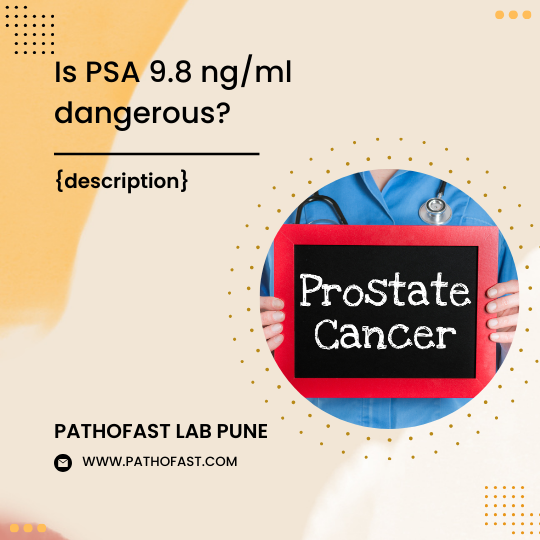
Is Total PSA 9.8 ng/ml dangerous?
In this article we discuss what a total PSA level of 9.8 means, together with its grading, causes, and whether it is good, bad or dangerous.
Published Date : 2024-02-03T14:02:06.297Z
Updated Date : 2024-02-03T14:02:06.297+00:00
Table of Contents
What is PSA?
How is PSA measured?
What is the normal range of PSA and how is a PSA of 9.8 graded?
Is a PSA of 9.8 dangerous?
What are the less dangerous causes of an elevated PSA level of 9.8?
Can A Digital Rectal Examination (DRE) tell you if a PSA of 9.8 is dangerous?
What was your previous PSA value?
With a PSA level of 9.8, what is your Prostate Volume?
What is your PSA density
Why do Free PSA levels matter with a total PSA of 9.8
Family History with a PSA Level of 9.8
References
What is PSA?
Total PSA, or Total Prostate Specific Antigen, is a hormone that the prostate gland releases into the bloodstream. Under normal circumstances, it exists in small amounts, but higher levels may be indicative of diseases, including various cancers.
How is PSA measured?
The measurement of PSA requires drawing a small blood sample using a syringe or needle, followed by analysis with automated analyzers in the laboratory. It's worth noting that different analyzers may yield slightly different results. A study demonstrated that the ECLIA technique generally produced higher results than the CMIA technique, with an average difference of 0.8 ug/L. To ensure reliable monitoring, it's recommended to consistently use one laboratory and one specific measurement technique for tracking your PSA levels.
What is the normal range of PSA and how is a PSA of 9.8 graded?
Normal Ranges of Total PSA levels vary according to age and ethnicity. Various studies have found considerable variation in the normal range depending upon country and ethnicity.
| Age Group | US Whites | Asians - Chinese | European - Spanish | Asians - Indians |
|---|---|---|---|---|
| Younger than 40 years | No data | No data | <1.4(Your value is 600% above normal) | <0.71(Your value is 1280% above normal) |
| 40-49 years | <2.1(Your value is 367% above normal) | <2.15(Your value is 356% above normal) | <1.7(Your value is 476% above normal) | <0.85(Your value is 1053% above normal) |
| 50-59 years | <3.6(Your value is 172% above normal) | <3.20(Your value is 206% above normal) | <3.3(Your value is 197% above normal) | <1.13(Your value is 767% above normal) |
| 60-69 years | <1.3(Your value is 654% above normal) | <4.10(Your value is 139% above normal) | <5.18(Your value is 89% above normal) | <1.45(Your value is 576% above normal) |
| 70-79 years | <5.8(Your value is 69% above normal) | <5.37(Your value is 82% above normal) | No Data | <1.84(Your value is 433% above normal) |
| 80 years and older | No data | No data | No data | <2.35(Your value is 317% above normal) |
Is a PSA of 9.8 dangerous?
A Total PSA level of 9.8 cannot be called 'good'. This is because values >= 4 have typically been designated as the cut-off for futher investigation, monitoring and in some cases - biopsy. Whether a value of 9.8 is to be considered worrying or dangerous depends on various factors as listed below.
What are the less dangerous causes of an elevated PSA level of 9.8?
Cancer is not the only cause of a raised PSA level. An elevated PSA can have various non-cancerous, and hence less dangerous causes. Each of these causes should be evaluated as well.
Non-Cancerous Prostate Tumors
Though not cancerous, these tumors can elevate PSA.
Age
PSA levels naturally tend to increase with age.
Ejaculation
PSA levels can rise after ejaculation.
Prostatitis
Inflammation of the prostate.
Prostate Biopsy
Recent prostate biopsy can temporarily elevate PSA levels.
Urinary Retention
Difficulty in emptying the bladder completely.
Medications
Certain medications, like finasteride or dutasteride, can affect PSA levels.
Urinary Tract Infection (UTI)
Infections in the urinary system.
Inflammation in the Body
Systemic inflammation can affect PSA levels.
Catheterization
Use of a catheter for urinary issues.
Vigorous Exercise
Strenuous physical activity can elevate PSA temporarily.
Trauma or Injury
Physical trauma to the prostate region.

Can A Digital Rectal Examination (DRE) tell you if a PSA of 9.8 is dangerous?
A digital rectal examination is a technique by which a doctor palpates your prostate gland with his/her fingers. Digital Rectal Examination is usually done when you have complaints of an enlarged prostate and its associated symptoms.
Is a digital rectal examination necessary for a PSA level of 9.8?
Any total PSA value above 4 usually warrants further investigation, and as such, your level of 9.8 should be accompanied by a DRE.
How is a Digital Rectal Examination Done?
During the prostate examination, the healthcare provider will use a lubricated finger to feel the prostate through the rectal wall, checking for any abnormalities or signs of potential problems.
Is a Digital Rectal Examination painful?
In general, a digital rectal examination is not painful, but some men may experience a temporary sensation of pressure or mild discomfort.
How does the result of a Digital Rectal Examination affect danger with a total PSA of 9.8?
A digital rectal examination is usually done when investigating patients for prostate health. Research shows that a positive DRE - when the doctor can feel nodules or hardening of your prostate, is associated with a higher risk of cancer. The table below elucidates describes your risk for a PSA of 9.8
.
| Digital Rectal Examination - Normal | Digital Rectal Examination - Suspicious/Abnormal |
|---|---|
| Your risk of cancer is 12% - 32% | Your risk of cancer is 42% - 72% |

What was your previous PSA value?
While deciding whether a PSA of 9.8 is dangerous, we need to track how fast it changes over time. An increase in PSA value of more than 20% over a period of 6 months to 2 years, is usually not a good sign.
Why is the change in PSA values over time important?
As per research, a fast increasing PSA values is more likely to be a fast growth, of some kind, which includes the possibility of cancer. Hence tracking the change in the value over time is important.
Over what period of time can the change be tracked?
In various studies, values upto 2 years ago were included while tracking the change in the value. So any previous value of PSA upto 2 years, ago, can be used to track the rate of change.
Should the two values be from the same laboratory?
PSA values can differ significantly depending on the method or technology used to measure them. It is absolutely essential to use the same lab and same method of measurement for serial measurements.
How much has your PSA level changed over time?
Based on research 2, the percentage change in your PSA value over time, has a direct bearing on the probability of cancer. If you have had your PSA done at any time in the past 2 years, the change in the value compared to today, can be very helpful in deciding what to do next. The table below assumes different values for your PSA level in the past and compares them with the present level.
| Your previous PSA value | What it means |
|---|---|
| Your previous PSA level was Less than or equal to 7.8 | Higher risk of cancer - your PSA has increased by more than or equal to 20%, this is a bad prognostic indicator. |
| Your previous PSA level was Greater than 7.8 | Lower risk of cancer - Your PSA has not increased by at least 20%, and this means it is not rapidly increasing, implying a good prognostic sign. |
| Greater than or equal to current 9.8 | Good sign - your PSA is either stable or reducing. |
With a PSA level of 9.8, what is your Prostate Volume?
Prostate volume is measured by your radiologist using an Ultrasound scan or USG. It can also be measured by MRI. Prostate volume can be used to decide whether you are at a greater risk, in the presence of a PSA level of 9.8
Why does prostate volume matter with a PSA of 9.8?
Prostate volume increases in both bening and cancerous growths. The amount of growth differs. In cancers, contrary to what we might expect, the total volume is lower, than in benign conditions.
What is the volume of your prostate?
Prostate volume is usually measured using Ultrasound(USG) or MRI or both. The volume of the prostate is a useful indicator, to tell the difference between normal enlargement and a cancer. This is because, a lower prostate volume, with a higher value of PSA is more likely to harbour a cancer. The table below gives you a summary.
Risk of Cancer with different prostate volumes for PSA levels 9.8 ng/ml
| Prostate Volume | Risk |
|---|---|
| 3.3 - 24.5 ml | Highest Risk |
| 24.5 - 45.7 | Higher Risk |
| 45.7 mL - 58.2 ml | Hard to predict |
| 45.7ml - 66.9ml | Lower Risk |
| 66.9 - 81ml | Lower Risk |
| >81ml | Lowest Risk |
What is your PSA density
PSA Density is basically your PSA level divided by your prostate volume. It has been proven to be useful in estimating risk associated with PSA levels above 4 ng/ml.
How is prostate density measured?
Prostate density needs both the volume and the level of PSA. So you will need a blood test to measure your PSA level and an ultrasound or MRI to measure the volume of your prostate.
Why does prostate density matter with a PSA of 9.8?
Prostate density attempts to combine the level of PSA and the size of the prostate to eliminate variables associated with both. The ratio can be used to predict prostate cancers.
Do you know your PSA Density?
The PSA density is a ratio calculated by dividing the PSA level by the volume of the prostate. It is often used to decide whether a patient with other suspicious findings should go ahead for a prostatic biopsy. A higher density has been associated with a higher risk of cancer. The table below depicts different PSA densities for your PSA level of 9.8.
| Prostate Volume | PSA Density | Risk |
|---|---|---|
| 20 | 0.5 | Higher Risk |
| 25 | 0.4 | Higher Risk |
| 30 | 0.3 | Higher Risk |
| 35 | 0.3 | Higher Risk |
| 40 | 0.2 | Higher Risk |
| 45 | 0.2 | Higher Risk |
| 50 | 0.2 | Higher Risk |
| 55 | 0.2 | Higher Risk |
| 60 | 0.2 | Higher Risk |
| 65 | 0.2 | Higher Risk |
| 70 | 0.1 | Lower Risk |
| 75 | 0.1 | Lower Risk |
| 80 | 0.1 | Lower Risk |
| 85 | 0.1 | Lower Risk |
| 90 | 0.1 | Lower Risk |
| 95 | 0.1 | Lower Risk |
| 100 | 0.1 | Lower Risk |
Why do Free PSA levels matter with a total PSA of 9.8
Free PSA is a component of the total PSA that has significance in predicting the risk of cancer.
How does free PSA differ from Total PSA?
Total PSA measures both free and complexed forms, while Free PSA selectively evaluates the unbound fraction for prostate cancer assessment.
How is free PSA measured?
Free PSA is measured through specialized assays that specifically target and quantify the unbound form of Prostate-Specific Antigen.
What was the result of your free PSA Level?
Free PSA is a subset of the total PSA measurement. It needs to be measured seperately, and is an independent test. The ratio of free PSA/ total PSA has been shown to help diagnose cancers. A low ratio, or lower percentage of free PSA is associated more commonly with cancers. As such, for values of total PSA between 4 and 10 , the %free PSA, may be useful in determining danger. The following table, estimates different values of %free PSA, for your value of total PSA of 9.8.
| Free PSA | %Free PSA | Risk |
|---|---|---|
| 0.7 | 7 | Higher Risk |
| 1.2 | 12 | Higher Risk |
| 1.6 | 16 | Higher Risk |
| 2.0 | 20 | Lower Risk |
| 2.5 | 25 | Lower Risk |
| 2.9 | 30 | Lower Risk |
Family History with a PSA Level of 9.8
Family history plays an important role in assesing the risk of cancern with PSA levels above 4.
Why is family history important while evaluating PSA?
There is evidence for genetic tendencies for prostate cancer.
Do you have any relatives with Prostate Cancer?
Irrespective of the value of Total PSA, men with at least one first-degree relative, who had prostate cancer, have a 10-15% higher chance of developing prostate cancer. Thus with a total PSA level of 9.8, knowing your family history could be useful.
References
- Prevalence of Prostate Cancer among Men with a Prostate-Specific Antigen Level ≤4.0 ng per Milliliter
- Association of PSA variability with prostate cancer development using large-scale medical information data: a retrospective cohort study
- Serdarevic N, Dabla P, Stanciu AE. Systematic Differences Between Total and Free Prostate-Specific Antigen Immunoassays: Comparison Using Passing and Bablok Regression. Indian J Clin Biochem. 2021 Apr;36(2):151-158. doi: 10.1007/s12291-019-0818-6. Epub 2019 Feb 13. PMID: 33867705; PMCID: PMC7994458.
- Song ZJ, Qian JK, Yang Y, Wu HX, Wang MY, Jiang SY, Wang FB, Zhang W, Chen R; Chinese Prostate Cancer Consortium. PSA density in the diagnosis of prostate cancer in the Chinese population: results from the Chinese Prostate Cancer Consortium. Asian J Androl. 2021 May-Jun;23(3):300-305. doi: 10.4103/aja.aja_61_20. PMID: 33208562; PMCID: PMC8152427.
- Normal Ranges of PSA in different ethnicities

